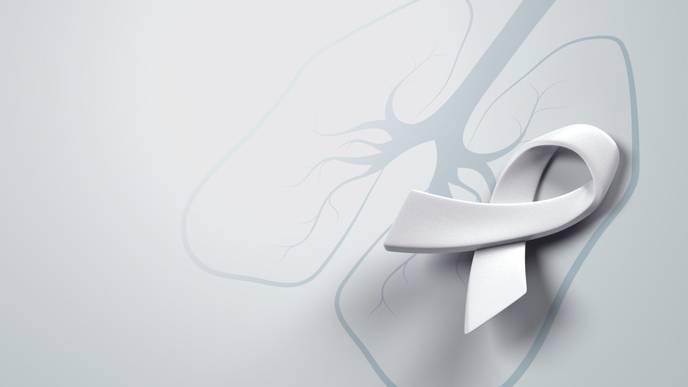ReachMD
Be part of the knowledge.™Genetics of Nearby Healthy Tissue May Help Catch Lung Cancer's Return

NEW YORK, Nov. 8, 2023 /PRNewswire/ -- Genetic information collected from seemingly healthy tissue near lung tumors may be a better predictor of whether cancer will come back after treatment than analysis of the tumors themselves, according to new research led by NYU Langone Health and its Perlmutter Cancer Center.
The new study focuses on lung adenocarcinoma, a cancer that forms in alveolar epithelial cells and accounts for about a third of all lung cancers in the United States, according to the U.S. Centers for Disease Control and Prevention. Most patients are cured if tumors are surgically removed early in the disease's progression, but residual cancer cells regrow in about 30% of cases and can lead to death. Consequently, experts have long searched for biomarkers, or predictors of recurrence, which might prompt more aggressive initial treatment.
The study included 147 men and women treated for early-stage lung cancer. It explored the utility value of the transcriptome, the complete set of RNA molecules that tell cells what proteins to make. Analysis of RNA collected from apparently healthy tissue adjacent to tumor cells accurately predicted that cancer would recur 83% of the time, while RNA from tumors themselves was only informative 63% of the time.
"Our findings suggest that the pattern of gene expression in apparently healthy tissue might serve as an effective and until now elusive biomarker to help predict lung-cancer recurrence in the earliest stages of the disease," said study co-lead author Igor Dolgalev, PhD.
Publishing online Nov. 8 in the journal Nature Communications, the investigation is the largest to date comparing genetic material from tumors and adjacent tissue and for their ability to predict recurrence, says Dolgalev, an assistant professor in the Department of Medicine at NYU Grossman School of Medicine and a member of Perlmutter Cancer Center.
For the study, the research team collected almost 300 tumor and healthy tissue samples from lung cancer patients. The study investigators then sequenced the RNA from each sample and fed these data, along with whether or not recurrence occurred within five years of surgery, into an artificial intelligence algorithm. This program used a technique called "machine learning" to build mathematical models that estimated recurrence risk.
The findings revealed that the expression of genes associated with inflammation, or heightened immune-system activity, in adjacent, apparently normal lung tissue, was especially useful for making predictions. This defensive reaction, the study authors say, should not be present in tissue that is truly healthy and may be an early warning sign of disease.
"Our results suggest that seemingly normal tissue that sits close to a tumor may not be healthy after all," said study co-lead author Hua Zhou, PhD, a bioinformatician at NYU Grossman and a member of Perlmutter Cancer Center. "Instead, escaped tumor cells might be triggering this unexpected immune response in their neighbors."
"Immunotherapy, which bolsters the body's immune defenses, might therefore help combat tumor growth before it becomes visible to traditional methods of detection," added study co-senior author and cancer biologist Aristotelis Tsirigos, PhD.
Tsirigos, a professor in the Department of Pathology at NYU Grossman and a member of Perlmutter Cancer Center, cautions that the investigation worked backwards, training the computer program using cases already known to have had disease return.
As a result, the study team next plans to use the program to prospectively assess recurrence risk in patients newly treated for early-stage lung cancer, says Tsirigos, who is also director of NYU Langone's Applied Bioinformatics Laboratories.
Funding for the study was provided by National Institutes of Health grants R37CA244775 and U01CA214195. Further support was provided by the American Association for Cancer Research Grant and the Roche Access to Distinguished Scientists Programme.
NYU Langone has a patent pending (TSI03-02PRO) for diagnostic tools developed from this approach. Tsirigos, Dolgalev, Zhou, study co-senior investigators Harvey Pass, MD; Andre Moreira, MD; and Leopoldo Segal, MD; as well as NYU Langone may benefit financially from this patent. The terms and conditions of these relationships are being managed in accordance with the policies of NYU Langone Health.
In addition to Dolgalev, Zhou, and Tsirigos, other NYU Langone researchers involved in the study are Hortense Le, MS; Theodore Sakellaropoulos, PhD; Nina Shenker-Tauris, MS; Nicolas Coudray, PhD; Varshini Vasudevaraja, MS; Kelsey Zhu, BS; Chandra Goparaju, PhD; Yonghua Li, MD, PhD; Imran Sulaiman, MD; Jun-Chieh Tsay, MD; Peter Meyn; Hussein Mohamed, PE; Iris Sydney, BA; Sitharam Ramaswami, PhD; Navneet Narula, MD; Luis Chiriboga, PhD; Adriana Heguy, PhD; Thales Papagiannakopoulos, PhD; Matija Snuderl, MD; Salman Punekar, MD; Vamsidhar Velcheti, MD; J.T. Poirier, PhD; Benjamin G. Neel, MD, PhD; and Kwok-Kin Wong, MD, PhD.
Additional coauthors are Anna Yeaton, BS, at the Broad Institute of MIT and Harvard University in Cambridge, Mass.; Ruth Kulicke, BS; Fred Davis, MD; Nicolas Stransky, PhD; and Gromoslaw Smolen, PhD; at Celsius Therapeutics, also in Cambridge; and Wei-Yi Cheng, PhD, and James Cai, PhD; at Roche Innovation Center in New York City.
Media Inquiries:
Shira Polan
Phone: 212-404-4279
shira.polan@nyulangone.org
View original content to download multimedia:https://www.prnewswire.com/news-releases/genetics-of-nearby-healthy-tissue-may-help-catch-lung-cancers-return-301972579.html
SOURCE NYU Grossman School of Medicine and NYU Langone Health
Facebook Comments